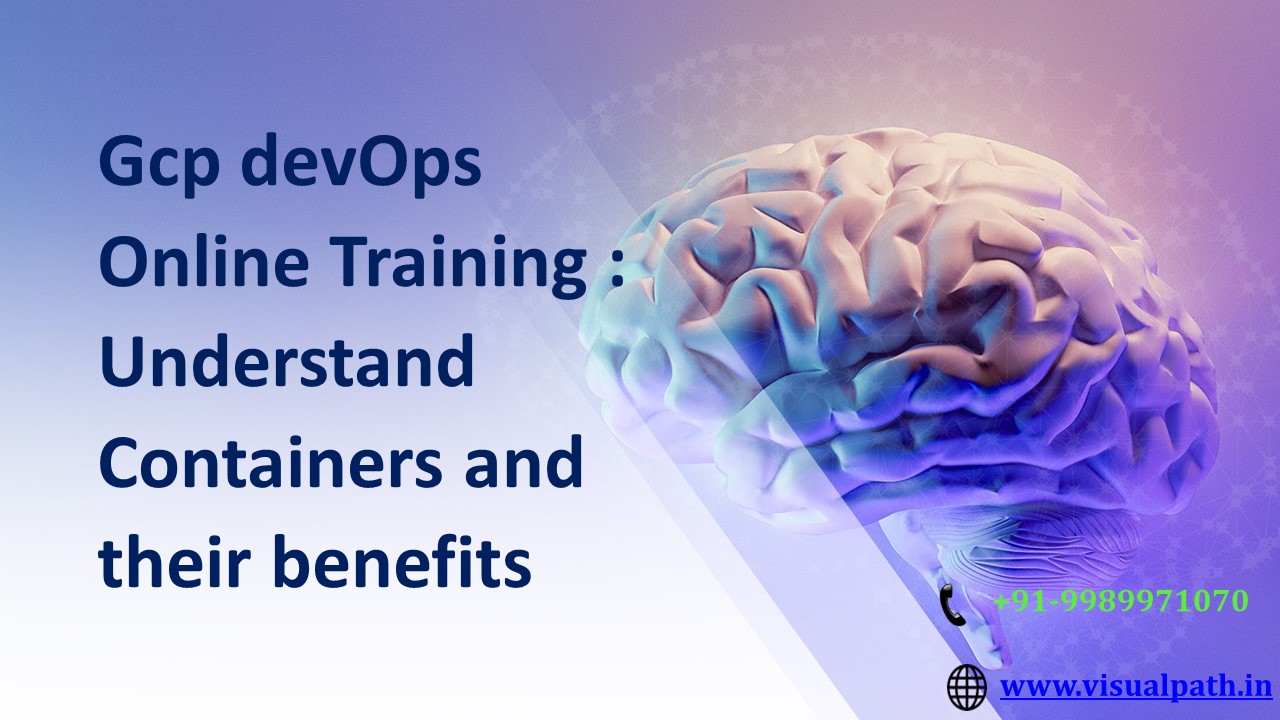DevOps On Google Cloud Platform Online Training - PowerPoint PPT Presentation
Title:
DevOps On Google Cloud Platform Online Training
Description:
DevOps On Google Cloud Platform Online Training - Visualpath is the Leading and DevOps On Google Cloud Platform Online Training. Avail complete job oriented DevOps On Google Cloud Platform Online Training Institute in Hyderabad by simply enrolling in our institute in Ameerpet. You will get the best course at an affordable cost. Call on - +91-9989971070 whatsApp: Visit : – PowerPoint PPT presentation
Number of Views:1
Title: DevOps On Google Cloud Platform Online Training
1
Gcp devOps Online Training Understand
Containers and their benefits
91-9989971070
www.visualpath.in
2
Introduction In the ever-evolving landscape of
technology, containers have emerged as a
game-changing solution for software deployment
and application management. This article aims to
provide a comprehensive understanding of
containers, shedding light on their architecture,
benefits, and the transformative impact they have
on the world of computing.
www.visualpath.in
3
I. Unpacking Containers A Brief
Overview Definition and Concept At its core, a
container is a lightweight, portable, and
self-sufficient unit that encapsulates an
application and its dependencies. Unlike
traditional virtualization methods, containers
operate at the application level, allowing for
efficient resource utilization and rapid
deployment. Key Components Containers consist of
three main components the application code,
runtime, and system tools. These elements are
bundled together, ensuring consistency across
different environments and simplifying the
deployment process.
www.visualpath.in
4
II. The Architecture of Containers Containerizatio
n vs. Virtualization To grasp the significance
of containers, it's essential to compare them
with traditional virtualization. Unlike virtual
machines (VMs) that require a hypervisor to run
multiple operating systems on a single host,
containers leverage the host OS, resulting in
faster and more resource-efficient
operations. Docker and Other Containerization
Platforms Docker, a leading containerization
platform, has played a pivotal role in
popularizing container technology. Other
platforms, such as Kubernetes, have emerged to
manage and orchestrate containerized applications
at scale. Understanding these platforms is
crucial for harnessing the full potential of
containers.
www.visualpath.in
5
III. Benefits of Containerization
1. Portability and Consistency Containers
encapsulate everything an application needs to
run, ensuring consistency across various
environments. This portability allows developers
to build, test, and deploy applications
seamlessly, regardless of the underlying
infrastructure. 2. Resource Efficiency Containers
share the host OS kernel, minimizing the
overhead associated with running multiple VMs.
This results in efficient resource utilization,
allowing organizations to maximize the use of
their hardware and reduce costs.
www.visualpath.in
6
3. Rapid Deployment Containers enable quick and
straightforward deployment of applications. The
encapsulated nature of containers eliminates
compatibility issues and reduces the risk of
conflicts between dependencies, facilitating
faster development cycles and time-to-market. 4.
Isolation and Security Containers provide a
level of isolation between applications,
enhancing security by limiting the potential
impact of vulnerabilities. Each container
operates independently, reducing the risk of
cross-contamination and making it easier to
manage security concerns.
www.visualpath.in
7
5. Scalability and Orchestration Containers are
inherently scalable, allowing applications to
scale up or down based on demand. Orchestration
platforms like Kubernetes automate the
deployment, scaling, and management of
containerized applications, providing a robust
solution for large-scale operations.
www.visualpath.in
8
IV. Real-world Applications of Containers 1.
Microservices Architecture Containers align
seamlessly with microservices architecture,
breaking down applications into smaller,
independently deployable units. This modular
approach enhances flexibility, scalability, and
fault isolation, making it easier to develop and
maintain complex applications. 2. DevOps
Integration Containers have become a cornerstone
of DevOps practices, fostering collaboration
between development and operations teams. The
consistency and repeatability offered by
containers streamline the integration of
continuous integration and continuous deployment
(CI/CD) pipelines.
www.visualpath.in
9
3. Multi-Cloud Deployments The portability of
containers makes them an ideal choice for
multi-cloud deployments. Organizations can
seamlessly move applications across different
cloud providers, avoiding vendor lock-in and
optimizing cost and performance based on specific
needs. V. Challenges and Considerations 1.
Learning Curve While containers offer numerous
benefits, there is a learning curve associated
with adopting containerization technologies.
Teams need to familiarize themselves with
container orchestration tools, management
platforms, and best practices to fully capitalize
on container benefits.
www.visualpath.in
10
2. Persistent Storage Managing persistent data
within containers poses a challenge. Unlike VMs,
containers are designed to be ephemeral, and
handling persistent storage requires additional
considerations and solutions. 3. Security
Concerns Although containers enhance security
through isolation, improper configurations or
vulnerabilities in container images can still
pose risks. Regular security audits, image
scanning, and adherence to best practices are
essential to mitigate potential threats.
www.visualpath.in
11
VII. Conclusion Embracing the Container
Revolution In conclusion, containers represent a
revolutionary approach to application deployment
and management, offering unparalleled benefits in
terms of portability, efficiency, and
scalability. As organizations strive to innovate
and optimize their IT infrastructure,
understanding and embracing containerization is
increasingly becoming a strategic imperative. By
doing so, businesses can unlock the full
potential of containers, ushering in a new era of
streamlined computing that aligns seamlessly with
the demands of the digital age.
www.visualpath.in
12
CONTACT
For More Information About Gcp DevOps Online
Training Address- Flat no 205, 2nd Floor
Nilgiri Block, Aditya
Enclave, Ameerpet,
Hyderabad-16 Ph No 91-9989971070 Visit
www.visualpath.in E-Mail
online_at_visualpath.in
13
THANK YOU































